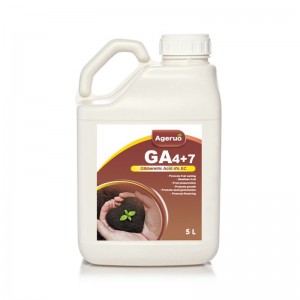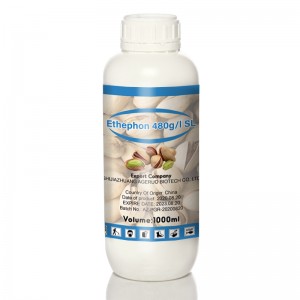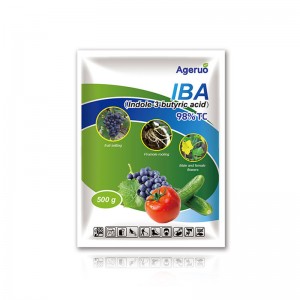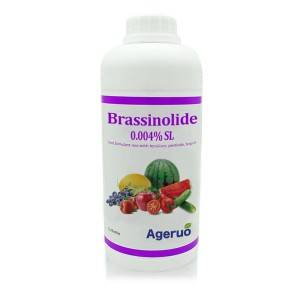Products
POMAIS Plant Growth Regulator Gibberellic Acid Ga4+7 4% EC
Introduction
| Active ingredients | Gibberellic acid (GA4+7) |
| CAS Number | 77-06-5 |
| Molecular Formula | C19H22O6 |
| Application | It can be used for rice, wheat, cotton, fruit trees, vegetables and other crops to promote their growth, germination, flowering and fruiting. |
| Brand Name | POMAIS |
| Shelf life | 2 Years |
| Purity | 4% EC |
| State | Liquid |
| Label | POMAIS or Customized |
| Formulations | 4% SL; 4% EC; 90% TC; 3% WP; 4.1% RC |
| The mixed formulation product | 6-benzylamino-purine 1.8% + gibberellic acid A4,A7 1.8% SLGibberellic acid 0.398% + 24-epibrassinolide 0.002% AG |
Gibberellic Acid GA4+7 4% EC is a professional plant growth regulator formulated as an emulsifiable concentrate containing a defined mixture of GA4 and GA7 at a total active content of 4%. You use this input to modulate plant physiology—not to kill pests or pathogens. In registered crops and timings, GA4+7 supports outcomes such as dormancy break, flowering synchronization/induction, fruit set and shape optimization, and size uniformity that improves pack-out consistency. The EC platform is engineered for predictable handling, stable storage, and consistent spray quality when used as directed on the local label.
For procurement, the value is a single-SKU PGR covering multiple quality objectives across orchards, vineyards, seed/tuber programs, nurseries, and protected cultivation where permitted. You receive compliance-ready documentation (COA/SDS/TDS) per lot and OEM options (multilingual labels, market-specific pack sizes). All claims, crops, timings, and intervals are label-dependent and may vary by country. This product is non-insecticidal and non-fungicidal; integrate it into your quality program alongside cultivar selection, canopy/nutrition management, and harvest standards, always following the approved local label and applicable regulations.
Package

Mode of Action & Physiological Effects
How it works (high level)
GA4+7 4% EC supplies exogenous gibberellins that activate the plant’s GA signaling pathway. When GA4/GA7 bind the endogenous receptor, growth restraints are lifted and cells elongate and divide more actively. At buds, this translates into dormancy release; around floral initiation and early fruiting, it supports flower organ differentiation and post-set development. This is a physiology modulator, not a pesticidal product.
What you can expect (label-dependent outcomes)
-
Dormancy break & uniform emergence: promotes bud activity and reduces uneven sprouting so you start cycles on a tighter schedule.
-
Flowering timing & synchrony: narrows the bloom window, improving labor planning and aligning with pollination strategies where permitted.
-
Fruit set & shape optimization: supports post-anthesis development for more consistent set and marketable shape in registered crops.
-
Size & pack-out uniformity: steadier cell expansion can raise the share of fruit meeting size/grade targets, improving pack efficiency.
-
Cluster/canopy architecture (vines & ornamentals): supports elongation where labeled, which you balance with pruning and nutrition to protect finish.
What determines response
Cultivar, phenology (exact timing), temperature, water/nutrient status, and stress history all influence outcomes. Start with small-block validation on sensitive varieties or under heat/salinity stress. Coordinate with pruning, thinning, irrigation, and nutrition programs to avoid excessive vegetative push. All uses, crops, timings, intervals, and precautions are governed by your approved local label; do not apply off-label or rely on generalized rates.
Application Scenarios
Fruit Trees (apple, pear, stone fruit)
You use GA4+7 4% EC to target quality outcomes tied to phenology windows—dormancy break, tighter bloom, stronger set, and improved fruit shape/finish where the product is registered. In practice, this lets you plan labor and thinning more predictably and lift the share of fruit meeting grade specs. Coordinate with pruning, canopy, and nutrition so elongation and set align with your pack-out goals. Always follow the approved label for crop, timing, and intervals.
Grapes & Vines (table/wine; open-field or protected)
Where permitted, GA4+7 4% EC supports cluster architecture and post-set development so you hit sizing and uniformity targets with fewer grading losses. You position it around flowering and early fruit growth to improve synchrony and downstream pack efficiency. Balance use with trellising, irrigation, and nutrition to avoid excessive vegetative push; confirm permissions for greenhouse vs open-field on your local label.
Seed/Tuber Programs (e.g., potato)
Dormancy management is the headline use where registered. You deploy GA4+7 4% EC to promote bud activity and a tighter emergence curve, improving field uniformity and harvest planning. Couple with seed sizing, storage temperature control, and sanitation protocols; verify label allowances for pre-plant handling versus in-field applications in your market.
Vegetables & Ornamentals (nursery, transplant lines)
In registered crops, you leverage GA4+7 4% EC to enhance emergence uniformity, flowering scheduling, and marketable appearance (height/shape). This is valuable for nursery lots and protected cultivation where consistent timing reduces rework and shrink. Integrate with IPM, irrigation, and fertigation programs; run small-block validation on sensitive cultivars.
Operational guardrails (applies to all scenarios)
-
This is a PGR—not insecticidal/fungicidal.
-
Outcomes depend on cultivar, timing, climate, and stress load; validate on a small area first.
-
Do not rely on generalized rates or off-label advice. All uses, crops, timings, intervals, and precautions must follow the approved local label.


Program Fit — Where GA4+7 4% EC Belongs
You position Gibberellic Acid GA4+7 4% EC at phenology-driven decision points where quality outcomes (uniformity, flowering window, fruit set/shape) determine pack-out. In orchards and vineyards, it integrates with pruning, thinning, and nutrition to tighten bloom and shape fruit in label-allowed crops. In seed/tuber programs, it supports dormancy break and synchronized emergence to stabilize field operations. Because GA responses are timing-sensitive, you base use on scouting and growth-stage verification, not on calendar dates. Coordinate applications with labor and logistics (pollination, thinning crews, harvest scheduling) to convert physiological gains into commercial grade. All timings, crops, intervals, and re-treat limits must follow your approved local label; validate sensitive cultivars in a small block before scale-up.
Compatibility & Handling (Principles)
-
Formulation: EC system designed for predictable metering and stable emulsions when used as directed.
-
Water quality & adjuvants: Use clean water. For any new partner or adjuvant, conduct a jar test first. Follow your local label and supplier guidance.
-
Loading discipline: Charge tank under agitation; observe standard order-of-addition practices for ECs; avoid stagnant dwell times.
-
Hygiene & residues: Keep induction hoppers and lines clean to prevent residues that could affect subsequent operations.
-
Storage: Keep sealed, cool, dry, and away from light. Reseal opened packs promptly; prevent contamination with fertilizers or other inputs.
-
Do not rely on generalized mixing recipes or non-label partners. Compatibility, partners, and any restrictions are label-dependent.
Selectivity & Safety
-
Crop selectivity: GA responses vary by cultivar, growth stage, and stress load (heat, salinity, drought). Run a small-block validation on sensitive varieties or under stress before scaling.
-
Personnel safety: Professional use only. Mix/load and apply with PPE and controls specified on the approved label and SDS. Observe REI and any ventilation or house-entry conditions for protected cultivation.
-
Environmental care: Follow buffer zones, avoid off-target deposition, and manage rinsates and containers under local regulations. Prevent spills from entering drains or natural waters.
-
Operational discipline: Calibrate equipment to ensure intended delivery; keep records for audits (lot code, date, crop, site). All use conditions are governed by your local registered label.
Packaging & OEM
-
Inner packs: HDPE bottles or drums with induction seal and tamper evidence; sizes configured to your route-to-market and label allowances.
-
Secondary & palletization: Export-grade cartons, liner protection, and pallet schemes optimized for container loading; corner/strap options available.
-
Private label: Multilingual labels (EN/ES/FR/AR/RU/PT, etc.), barcode/serialization, and optional QR to e-leaflet. Artwork aligned to your brand while preserving mandatory statements.
-
Deliverables: Editable label/carton files, dielines, print-ready PDFs, and master data (SKU codes, inner/outer dimensions, net/gross weights) for ERP onboarding.
-
Process: Artwork brief → compliance check against local label → digital proof → color standard → print release. Final claims and pictograms are label-driven.
QC & Documents
-
Lot release controls: Active content, appearance range, specific gravity/pH (per spec), emulsion behavior, and storage stability checkpoints.
-
Traceability: Lot coding from raw materials to finished packs; retention samples archived per lot for investigation and audits.
-
Stability: Accelerated and real-time programs support shelf-life statements and packaging compatibility.
-
Documents supplied: COA / SDS / TDS per lot; registration support bundle (label drafts, carton markings, packaging specs) on request.
-
Receiving checks: Verify tamper evidence, pack integrity, labeling, lot codes, and COA conformance before QA release to operations.
Regulatory Note
GA4+7 products are registration-bound. Your final claims (crops, timings, intervals, number of applications, protected vs open field) and hazard communications must mirror the approved local label. Only trained personnel should handle and apply. Do not publish or communicate instructions beyond the registered document. For export-oriented growers, align timing with buyer requirements and destination-market regulations. Where national rules impose additional constraints on PGRs, integrate them into your SOP before purchase.
FAQ — GA4+7 4% EC
Q1. What is GA4+7 4% EC used for?
A label-dependent plant growth regulator to support dormancy break, flowering synchronization, fruit set/shape, and size uniformity in registered crops.
Q2. How is it different from GA3?
GA4+7 is a specific gibberellin blend positioned for targeted phenology windows. Final uses and timings differ by label; do not extrapolate between PGRs.
Q3. Which crops are typically registered?
Market-specific. Confirm your local label for permitted crops (e.g., selected fruit trees, vines, seed/tuber programs, protected ornamentals).
Q4. Can I tank mix it?
Only as permitted. Perform a jar test for any new partner and follow label-stated compatibility and order-of-addition principles.
Q5. What influences response?
Cultivar, exact timing, temperature, water/nutrient status, and stress history. Validate on a small block before scale-up.
Q6. What documents and QA data do I receive?
COA/SDS/TDS with each lot, plus packaging specs and label drafts for compliance review.
Q7. Do you support multilingual private label?
Yes. We provide multilingual artwork, serialization, and QR e-leaflets aligned to your approved label.















